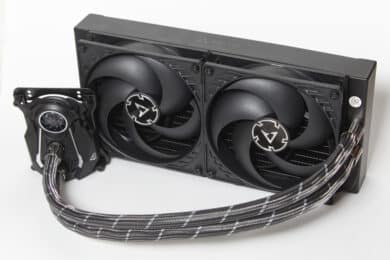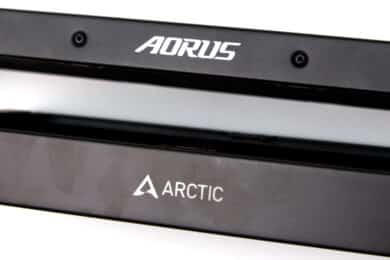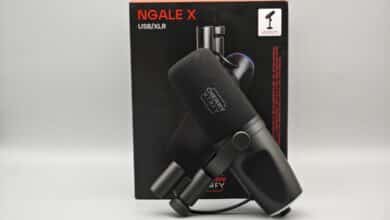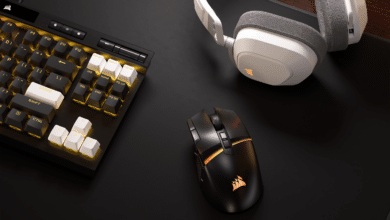
All-in-one water cooling systems, or AIO for short, were still a niche in the enthusiast sector until a few years ago, and custom water cooling systems were a nerdy speciality. However, this has changed in the meantime and you can find radiators in modern computers more and more often. Accordingly, the relevance of fans that do their job as quietly as possible yet efficiently on the radiators is increasing. We have collected a larger number of 140 mm fans here and tested them against each other in the radiator fan test.
The fans in the test
| Image | Fan name | Rotation speed |
Warranty in years |
RGB connector |
Price |
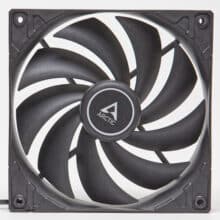 |
Arctic F14 PWM PST (Rev. 5) | 1350 | 6 | – | € 62.14 *
(set of 5) € 20.53 * (single) |
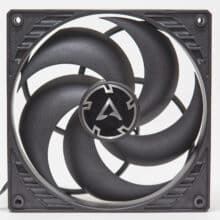 |
Arctic P14 PWM | 1800 | 6 | – | € 29.81 *
(set of 5) € 17.39 * (single) |
 |
Arctic P14 PWM PST A-RGB | 1900 | 6 | Standard ARGB | € 45.52 * (set of 3) € 19.99 * (single) |
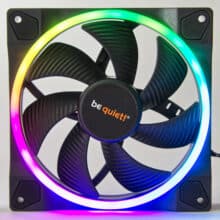 |
be quiet! Light Wings 140mm PWM | 1500 | 3 | Standard ARGB | € 65.89 * (set of 3) € 29.98 * (single) |
 |
be quiet! Pure Wings 2 140mm PWM | 1000 | 3 | – | € 15.00 * |
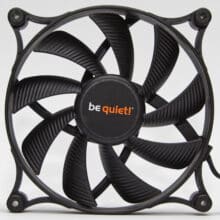 |
be quiet! Shadow Wings 2 140mm PWM | 900 | 3 | – | € 17.98 * (black) € 15.90 * (white) |
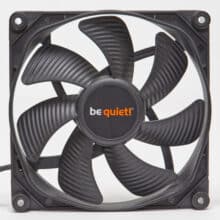 |
Be quiet! Silent Wings 3 140mm High-Speed |
1600 | 3 | – | € 62.67 * |
 |
be quiet! Silent Wings Pro 4 140mm |
2400 | 5 | – | € 33.64 * |
 |
Corsair AF140 Elite | 1600 | 5 | – | € 17.90 * |
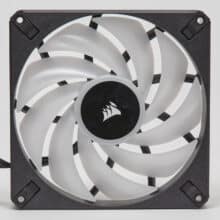 |
Corsair iCue AF140 RGB Elite |
1700 | 5 | Owner (Corsair iCue) | € 49.90 * |
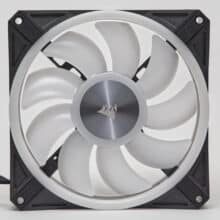 |
Corsair iCue QL140 RGB |
1250 | 2 | Owner (Corsair iCue) | € 26.89 *
(black) € 34.00 * (white) |
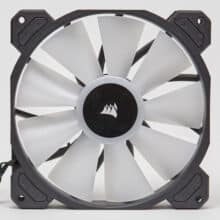 |
Corsair iCue SP140 RGB Elite |
1200 | 2 | Owner (Corsair iCue) | € 32.50 *
(set of 2, black) € 23.90 * (single, white) |
 |
ENDORFY Fluctus 140 PWM ARGB |
1800 | 6 | Standard ARGB | € 21.00 * |
 |
Inter-Tech Argus RS-14 |
1200 | 2 | Proprietary with adapter to standard ARGB in the set | € 32.99 * (set of 3) |
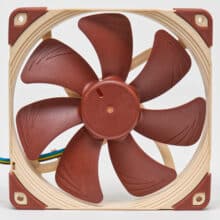 |
Noctua NF-A14 | 1500 | 6 | – | € 21.00 *
(brown) € 29.90 * (Chromax Black) |
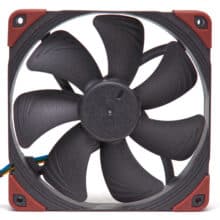 |
Noctua NF-A14 industrialPPC-3000 PWM | 3000 | 6 | – | € 31.95 * |
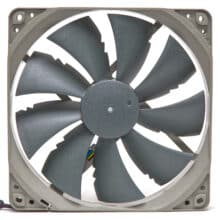 |
Noctua NF-P14 redux | 1500 | 6 | – | € 17.90 * |
 |
NZXT F140 RGB | 1800 | 2 | Owner (NZXT Cam) | € 30.89 * (black) € 30.89 * (white) |
 |
Xilence XPF140.R.PWM |
1500 | 2 | – | € 5.11 * |
Test system
For the radiator fan test, Arctic provided us with the Liquid Freezer II 280 Rev. 7. The Arctic Liquid Freezer is well suited for this test for several reasons:
- With its high thickness of 38 mm, it increases the resistance compared to regular AIOs with about 25 mm. This also emphasizes the difference in performance of the fans.
- With its integrated fan splitter, it makes our test easier with simpler wiring for frequent fan changes.
- His relatively low price for an AIO of € 75.90 * makes it accessible to many buyers. It is therefore widely used and represents a good reference point.
The cooler is used on an AMD Ryzen 9 5950X, which draws between 150 and 160 watts (CPU Package Power) when loaded with Cinebench at a 4.20-Ghz all-core overclock (1.15V peak core voltage), depending on the temperature. The cooler sits in the front of the Fractal Design Pop XL Air. The only case fans used are one each of be quiet! Silent Wings Pro 4 in 120 mm (rear top) and 140 mm (rear), which have as little impact as possible on the test result on an established low speed (120 mm: 800 RPM / 140 mm: 500 RPM).
At the front of the case, the radiator is attached for two reasons. On the one hand, this makes it easier to change the fans because no components inside get in the way. On the other hand, the front grille adds as resistance that has to be overcome.
Little disclaimer
Admittedly, this cooler also has a previously unconsidered problem in the test, which definitely has an impact on our test results: The pump is controlled along with the fans. This has an impact on both the volume measurement (which negatively affects the volume results for slower spinning fans, and thus their performance results in the 31 dB(A) test) and the performance for high performance fans (which can affect the temperature results for the heavily down regulated fans). Due to the widespread use of the cooler and the significant differences in performance even with similarly fast fans, the measurement results remain valid, but this should still be considered when interpreting the results.
Test procedure
For a constant result, the system is heated up with Cinebench for 10 minutes and then a measurement is taken in the duration of one minute. The room temperature is subtracted from the measured result to exclude this variable as well. This difference is given as a delta in Kelvin.
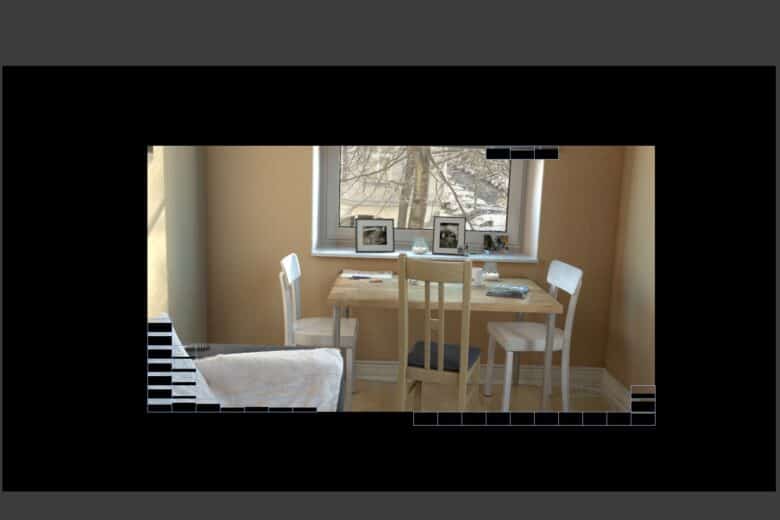
This test is repeated three times per fan. Once at 800 rpm, because this is a speed that each of the 140 mm fans can definitely reach. The second test is performed at a uniform volume development. This run shows which fan offers the highest performance in an almost inaudible state. This test may well be influenced by the fact that some fans become louder in interaction with the front grille of the case than in a pure push configuration without additional resistance. In other words, fans in the front of the case will be louder and have more resistance than when the radiator is used in the top of the case. The last test is performed at full speed.
Test with 800 RPM
The radiator fan test at 800 RPM is performed because any of the fans can reach this speed. Moreover, this speed is often close to the sweet spot of performance and noise. This list is sorted by temperature delta. If the temperature delta is identical, the lower noise wins. The purpose of this test is to determine the highest efficiency of a fan.
| wdt_ID | Name | Lautstärke (dB(A)) | Temperaturdelta in Kelvin |
|---|---|---|---|
| 1 | Corsair iCue SP140 RGB Elite | 34,70 | 39,10 |
| 2 | Corsair AF140 Elite | 32,40 | 39,60 |
| 3 | Arctic F14 PWM PST | 35,10 | 39,60 |
| 4 | Noctua NF-P14s redux-1500 PWM | 35,50 | 39,70 |
| 5 | Noctua NF-A14 PWM | 35,10 | 39,80 |
| 6 | Corsair iCue AF140 RGB Elite | 31,20 | 40,60 |
| 7 | Noctua NF-A14 industrialPPC-3000 | 36,90 | 40,80 |
| 8 | be quiet! Pure Wings 2 140mm PWM | 35,50 | 40,90 |
| 9 | Arctic P14 PWM | 31,20 | 41,00 |
| 10 | be quiet! Light Wings 140mm PWM | 31,00 | 41,10 |
| 11 | Sharkoon SilentStorm 140 PWM RGB | 32,90 | 41,20 |
| 12 | Xilence XPF140.R.PWM | 35,50 | 41,40 |
| 13 | ENDORFY Fluctus 140 PWM ARGB | 31,80 | 41,50 |
| 14 | be quiet! Silent Wings 3 140mm High-Speed | 32,90 | 42,10 |
| 15 | Arctic P14 PWM PST ARGB | 31,80 | 42,20 |
| 17 | Lian Li Uni Fan AL140 V2 | 31,00 | 42,70 |
| 18 | be quiet! Shadow Wings 2 140mm PWM | 31,80 | 42,70 |
| 19 | Thermaltake TOUGHFAN 14 RGB | 31,00 | 42,90 |
| 20 | be quiet! Silent Wings Pro 4 140mm | 31,20 | 43,20 |
| 24 | NZXT F140 RGB | 32,40 | 43,30 |
| 26 | Corsair iCue QL140 RGB | 31,80 | 44,30 |
| 27 | Inter-Tech Argus RS-14 | 31,20 | 45,00 |
| Name | Lautstärke (dB(A)) | Temperaturdelta in Kelvin |
Analysis of speed efficiency
Corsair takes the top spot in the 800 RPM range with two fans in this radiator fan test. The SP140 RGB Elite are not exactly the quietest fans in the comparison, but they perform well. The Corsair AF140 Elite are close behind, but do the job more quietly. The RGB version of the AF140 is even quieter and is only a few places behind. Unexpectedly, the Arctic F140s beat out Noctua for third place, and while not exactly quiet, they do play within the measurement tolerance range of the Noctua NF-A14 and NF-P14s redux-1500 in terms of performance and volume. The Noctua NF-A14 industrialPPC are louder and slightly weaker than the cheaper standard model in this range.
The strongest RGB fans in the test are the two Corsair fans SP140 RGB and AF140 RGB Elite. The strongest non-proprietary RGB fan model in this test is the be quiet! Light Wings 140mm, followed by the ENDORFY Fluctus 140 PWM ARGB.
In this test, the three fans with the wide RGB frame are lagging behind and thus have shorter fan blades. These are the NZXT F140 RGB, the Corsair QL140 RGB and the Argus RS-14. At least these models are rather quieter than most fans at the upper performance end of the test.
Test at 31 dB(A)
The radiator fan test at a uniform volume was chosen so that the volume is within the perception limit of the measuring device. At this volume, the fans are virtually inaudible. The speed is determined by the volume meter perceiving the first minimum deflection above the base noise of the system (especially the radiator pump). The purpose of this test is to find out the best inaudible performance.
| wdt_ID | Name | Drehzahl (RPM) | Temperaturdelta in Kelvin |
|---|---|---|---|
| 1 | be quiet! Light Wings 140mm PWM | 800 | 41,10 |
| 2 | Corsair iCue AF140 RGB Elite | 750 | 41,90 |
| 3 | ENDORFY Fluctus 140 PWM ARGB | 720 | 42,50 |
| 4 | Corsair AF140 Elite | 690 | 42,60 |
| 5 | Arctic P14 PWM | 720 | 42,60 |
| 6 | Lian Li Uni Fan AL140 V2 | 800 | 42,70 |
| 7 | Thermaltake TOUGHFAN 14 RGB | 800 | 42,90 |
| 8 | Corsair iCue SP140 RGB Elite | 610 | 43,10 |
| 9 | be quiet! Shadow Wings 2 140mm PWM | 760 | 43,50 |
| 10 | Arctic P14 PWM PST ARGB | 740 | 43,60 |
| 11 | Arctic F14 PWM PST | 630 | 44,00 |
| 12 | Noctua NF-P14s redux-1500 PWM | 600 | 44,10 |
| 13 | be quiet! Silent Wings Pro 4 140mm | 760 | 44,20 |
| 14 | Sharkoon SilentStorm 140 PWM RGB | 695 | 44,30 |
| 15 | Noctua NF-A14 PWM | 600 | 44,70 |
| 16 | Corsair iCue QL140 RGB | 750 | 45,10 |
| 18 | NZXT F140 RGB | 700 | 45,80 |
| 19 | Inter-Tech Argus RS-14 | 720 | 46,70 |
| 21 | be quiet! Silent Wings 3 140mm High-Speed | 610 | 47,50 |
| 23 | be quiet! Pure Wings 2 140mm PWM | 570 | 47,50 |
| 25 | Noctua NF-A14 industrialPPC-3000 | 470 | 50,50 |
| Name | Drehzahl (RPM) | Temperaturdelta in Kelvin |
Low volume radiator fan test results
Where the 800 RPM tests saw a lot of louder models take the top spot, this test pushes the volume down to the inaudible limit, which of course favors the quieter fans that don’t need to be turned down as far. At the top now sit three RGB fans at once, be quiet! Light Wings, the Corsair AF140 RGB Elite and the ENDORFY Fluctus 140 ARGB. They are followed by the Corsair AF140 Elite and Arctic P14, which perform equally well.
For once, the Argus RS-14 and Corsair QL140 hit a bit further up front, as they don’t need to be dialed down as far. Instead, we find the Noctua NF-A14 industrialPPC-3000 at the bottom, which had to be dialed down very far with a higher base noise than the regular variant. the be quiet! Silent Wings 3 High-Speed lose performance faster than other models due to the low speed and therefore also end up at the bottom.
The Xilence XPF140.R.PWM was excluded from the test because it cannot be reduced below a certain speed and thus cannot reach the targeted volume level.
Test with maximum power
The test at full speed shows the fan’s maximum potential. Here, the fans are simply set to full power. This gives you the highest possible performance of the fan when the volume is not relevant. The volume is still measured as a point of reference. However, it is sorted completely according to the reached temperature delta.
| wdt_ID | Name | Drehzahl (RPM) | Lautstärke (dB(A)) | Temperaturdelta in Kelvin |
|---|---|---|---|---|
| 1 | Noctua NF-A14 industrialPPC-3000 | 2.670 | 67,10 | 32,30 |
| 2 | be quiet! Silent Wings Pro 4 140mm | 2.130 | 54,40 | 32,40 |
| 3 | ENDORFY Fluctus 140 PWM ARGB | 1.900 | 53,70 | 33,00 |
| 4 | Corsair AF140 Elite | 1.610 | 51,60 | 33,50 |
| 5 | Corsair iCue AF140 RGB Elite | 1.730 | 54,10 | 33,60 |
| 6 | Arctic P14 PWM PST ARGB | 1.780 | 48,30 | 34,00 |
| 7 | Noctua NF-P14s redux-1500 PWM | 1.500 | 53,40 | 34,00 |
| 8 | Thermaltake TOUGHFAN 14 RGB | 2.100 | 56,40 | 34,10 |
| 9 | Arctic P14 PWM | 1.610 | 47,20 | 34,40 |
| 10 | be quiet! Light Wings 140mm PWM | 1.440 | 42,80 | 34,50 |
| 11 | Lian Li Uni Fan AL140 V2 | 1.600 | 46,80 | 34,50 |
| 12 | Noctua NF-A14 PWM | 1.440 | 51,50 | 34,70 |
| 13 | NZXT F140 RGB | 1.700 | 52,70 | 34,70 |
| 14 | Arctic F14 PWM PST | 1.290 | 48,10 | 34,80 |
| 15 | be quiet! Silent Wings 3 140mm High-Speed | 1.530 | 47,90 | 34,90 |
| 17 | Corsair iCue SP140 RGB Elite | 1.180 | 45,20 | 35,50 |
| 18 | Xilence XPF140.R.PWM | 1.350 | 49,60 | 35,50 |
| 19 | Sharkoon SilentStorm 140 PWM RGB | 1.320 | 46,60 | 36,20 |
| 20 | Corsair iCue QL140 RGB | 1.330 | 45,20 | 37,00 |
| 22 | be quiet! Pure Wings 2 140mm PWM | 890 | 37,20 | 39,60 |
| 24 | Inter-Tech Argus RS-14 | 1.090 | 38,10 | 40,20 |
| 26 | be quiet! Shadow Wings 2 140mm PWM | 820 | 32,40 | 42,10 |
| Name | Drehzahl (RPM) | Lautstärke (dB(A)) | Temperaturdelta in Kelvin |
Analysis of peak performance results
Clearly – this test is largely based on a high speed. Accordingly, the slower and mostly quieter fans are found at the lower performance end, while it gets faster and tends to get louder towards the top. However, there are outliers in both directions. For example, the Xilence XPF140.R.PWM can be found relatively far down the list, which gets relatively loud despite the unconvincing performance. However, the Corsair QL140 and Argus RS-14 follow with larger gaps in terms of performance, along with the slower be-quiet! fans. While the general performance of the Xilence fans is not outstanding, they still sit much closer to the midfield (at the same performance level of the quieter Corsair SP140 RGB).
Unsurprisingly, the Noctua NF-A14 industrialPPC-3000 wins this test due to its raw power and high speed. Even though the noise level is really unpleasantly high. Significantly quieter and very close in terms of performance are the be quiet! Silent Wings Pro 4 140 mm in this test, which are clearly more effective in this case. The strongest RGB fan we have in this test is the ENDORFY Fluctus 140 ARGB, which is also not too far behind the be quiet! Silent Wings Pro 4. The Corsair AF140 in black and RGB also follow with strong results. The strongest fan that falls short of 50 dB(A) is the Arctic P14 ARGB.
The inexpensive Noctua NF-P14s redux-1500 beats the more expensive NF-A14 PWM in terms of performance, which is hardly surprising due to the pressure-optimized design. (On the subject of fan design, see: fan tutorial: things to know about fans in PCs) A largely identical performance to the NF-A14 PWM is achieved by the be quiet! Light Wings 140mm at a much lower noise level. Impressive.
The overall winners of the test
In the big radiator fan test, the results diverge further than in the parallel test of the case fans.
Overall, there are no complete outliers that should prevent a purchase if you like the fans design-wise. However, those who bought an AIO with working fans will hardly benefit from switching to the Xilence XPF140, the Corsair QL140 or the Argus RS-14.
In contrast, a winner (pair) crystallizes. Among the candidates in the test, the Corsair AF140 Elite in both the monochrome and RGB variants come out on top on average. These fans are found quite far ahead in each of the three tests and offer a wide speed range, high efficiency and low noise.
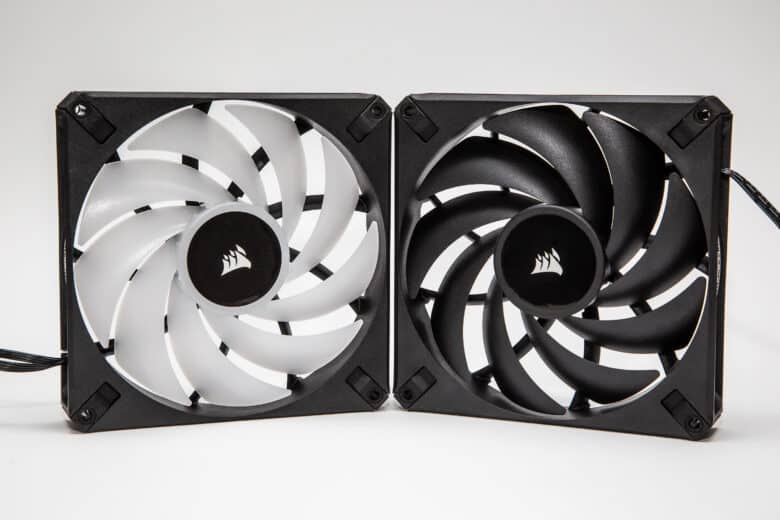
In the RGB range, the ENDORFY Fluctus 140 ARGB and the be quiet! Light Wings 140mm PWM are also very solid performing fans, with the be quiet! being slightly quieter and the ENDORFY offering a slightly higher maximum output.
Also worth mentioning are the two variants of the Arctic P14, which score with a solid performance at a low volume – and that at a quite low price compared to the previously mentioned competition.
Noctua’s NF-P14s redux are also reasonably affordable and deliver a convincing performance, but land rather in the midfield in the overall comparison together with the NF-A14s. The age of the fan concepts becomes somewhat apparent here.
Conclusion
The overall winners of this test are the Corsair AF140 Elite in both the regular and RGB versions. These fans land in good places in all tests – they are quiet, efficient and also offer high overall performance.
In the RGB field, the Corsair iCue AF140 RGB Elite is also a winner. Those who don’t want to rely on the proprietary iCue system will find strong and quiet options in the be quiet! Light Wings 140mm PWM and the ENDORFY Fluctus 140 PWM ARGB. The Light Wings come with an illuminated frame here, while the Fluctus have illuminated fan blades.
In the budget range, the Arctic P14s do very solidly in the regular and ARGB variants and achieve very solid results at a relatively low volume despite their low price.
